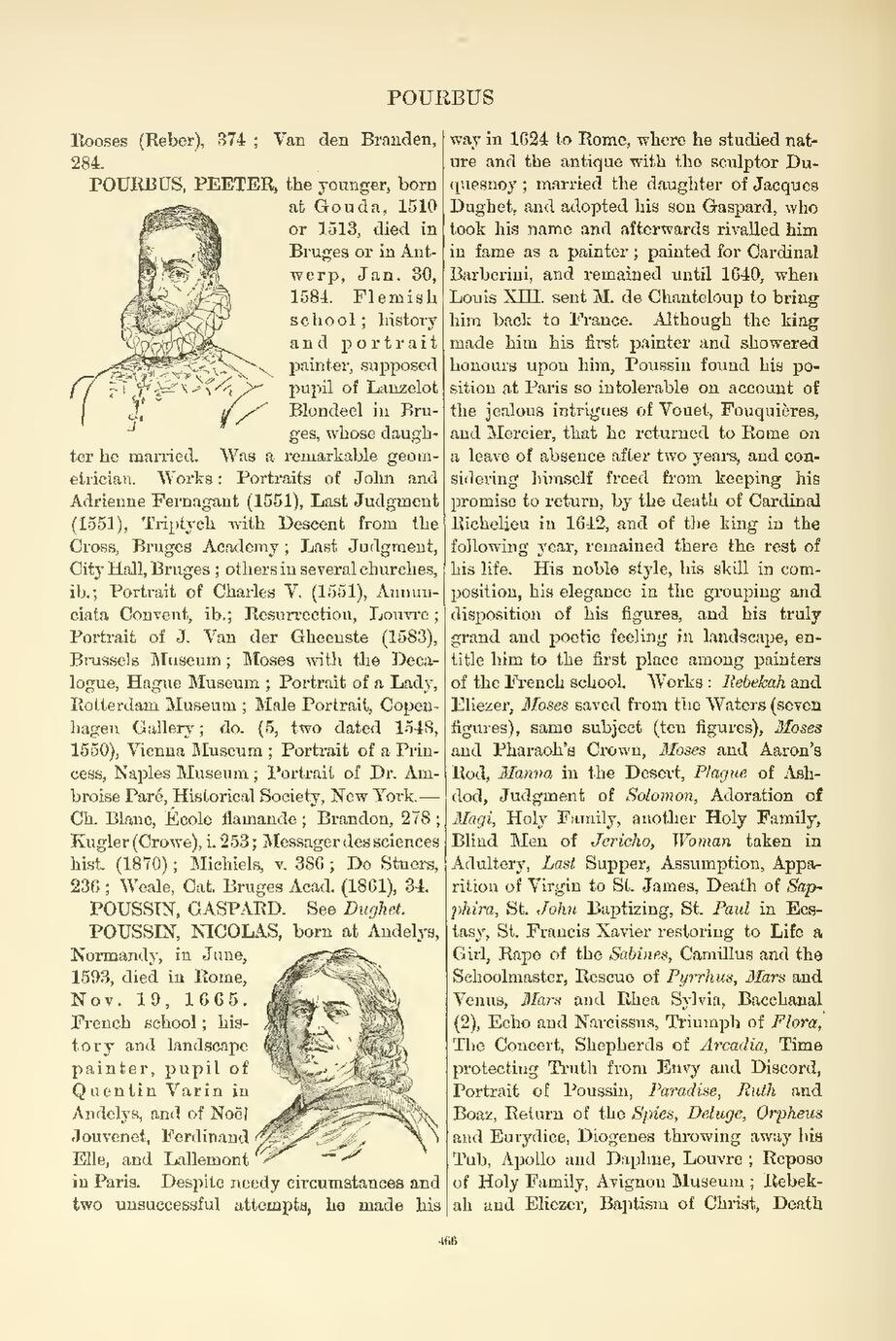Rooses (Reber), 374; Van den Branden, 284.
An image should appear at this position in the text. To use the entire page scan as a placeholder, edit this page and replace "{{missing image}}" with "{{raw image|Cyclopedia of painters and paintings (IA cyclopediaofpain03cham).pdf/488}}". Otherwise, if you are able to provide the image then please do so. For guidance, see Wikisource:Image guidelines and Help:Adding images. |
POURBUS, PEETER, the younger, born
at Gouda, 1510
or 1513, died in
Bruges or in Antwerp,
Jan. 30,
1584. Flemish
school; history
and portrait
painter, supposed
pupil of Lanzelot
Blondeel in Bruges,
whose daughter
he married. Was a remarkable geometrician.
Works: Portraits of John and
Adrienne Fernagant (1551), Last Judgment
(1551), Triptych with Descent from the
Cross, Bruges Academy; Last Judgment,
City Hall, Bruges; others in several churches,
ib.; Portrait of Charles V. (1551), Annunciata
Convent, ib.; Resurrection, Louvre;
Portrait of J. Van der Gheenste (1583),
Brussels Museum; Moses with the Decalogue,
Hague Museum; Portrait of a Lady,
Rotterdam Museum; Male Portrait, Copenhagen
Gallery; do. (5, two dated 1548,
1550), Vienna Museum; Portrait of a Princess,
Naples Museum; Portrait of Dr. Ambroise
Paré, Historical Society, New York.—Ch.
Blanc, École flamande; Brandon, 278;
Kugler (Crowe), i. 253; Messager des sciences
hist. (1870); Michiels, v. 386; De Stuers,
236; Weale, Cat. Bruges Acad. (1861), 34.
POUSSIN, GASPARD. See Dughet.
An image should appear at this position in the text. To use the entire page scan as a placeholder, edit this page and replace "{{missing image}}" with "{{raw image|Cyclopedia of painters and paintings (IA cyclopediaofpain03cham).pdf/488}}". Otherwise, if you are able to provide the image then please do so. For guidance, see Wikisource:Image guidelines and Help:Adding images. |
POUSSIN, NICOLAS, born at Andelys,
Normandy, in June,
1593, died in Rome,
Nov. 19, 1665.
French school; history
and landscape
painter, pupil of
Quentin Varin in
Andelys, and of Noël
Jouvenet, Ferdinand
Elle, and Lallemont
in Paris. Despite needy circumstances and
two unsuccessful attempts, he made his
way in 1624 to Rome, where he studied nature
and the antique with the sculptor Duquesnoy;
married the daughter of Jacques
Dughet, and adopted his son Gaspard, who
took his name and afterwards rivalled him
in fame as a painter; painted for Cardinal
Barberini, and remained until 1640, when
Louis XIII. sent M. de Chanteloup to bring
him back to France. Although the king
made him his first painter and showered
honours upon him, Poussin found his position
at Paris so intolerable on account of
the jealous intrigues of Vouet, Fouquières,
and Mercier, that he returned to Rome on
a leave of absence after two years, and considering
himself freed from keeping his
promise to return, by the death of Cardinal
Richelieu in 1642, and of the king in the
following year, remained there the rest of
his life. His noble style, his skill in composition,
his elegance in the grouping and
disposition of his figures, and his truly
grand and poetic feeling in landscape, entitle
him to the first place among painters
of the French school. Works: Rebekah and
Eliezer, Moses saved from the Waters (seven
figures), same subject (ten figures), Moses
and Pharaoh's Crown, Moses and Aaron's
Rod, Manna in the Desert, Plague of Ashdod,
Judgment of Solomon, Adoration of
Magi, Holy Family, another Holy Family,
Blind Men of Jericho, Woman taken in
Adultery, Last Supper, Assumption, Apparition
of Virgin to St. James, Death of Sapphira,
St. John Baptizing, St. Paul in Ecstasy,
St. Francis Xavier restoring to Life a
Girl, Rape of the Sabines, Camillus and the
Schoolmaster, Rescue of Pyrrhus, Mars and
Venus, Mars and Rhea Sylvia, Bacchanal
(2), Echo and Narcissus, Triumph of Flora,
The Concert, Shepherds of Arcadia, Time
protecting Truth from Envy and Discord,
Portrait of Poussin, Paradise, Ruth and
Boaz, Return of the Spies, Deluge, Orpheus
and Eurydice, Diogenes throwing away his
Tub, Apollo and Daphne, Louvre; Repose
of Holy Family, Avignon Museum; Rebekah
and Eliezer, Baptism of Christ, Death
